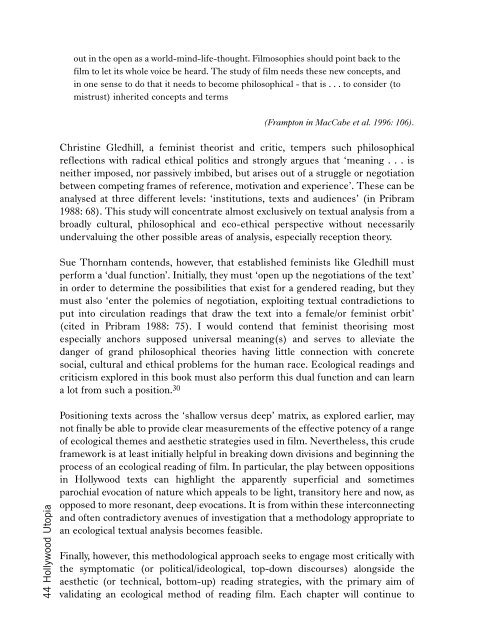Hollywood Utopia
Hollywood Utopia
Hollywood Utopia
You also want an ePaper? Increase the reach of your titles
YUMPU automatically turns print PDFs into web optimized ePapers that Google loves.
44 <strong>Hollywood</strong> <strong>Utopia</strong><br />
out in the open as a world-mind-life-thought. Filmosophies should point back to the<br />
film to let its whole voice be heard. The study of film needs these new concepts, and<br />
in one sense to do that it needs to become philosophical - that is . . . to consider (to<br />
mistrust) inherited concepts and terms<br />
(Frampton in MacCabe et al. 1996: 106).<br />
Christine Gledhill, a feminist theorist and critic, tempers such philosophical<br />
reflections with radical ethical politics and strongly argues that ‘meaning . . . is<br />
neither imposed, nor passively imbibed, but arises out of a struggle or negotiation<br />
between competing frames of reference, motivation and experience’. These can be<br />
analysed at three different levels: ‘institutions, texts and audiences’ (in Pribram<br />
1988: 68). This study will concentrate almost exclusively on textual analysis from a<br />
broadly cultural, philosophical and eco-ethical perspective without necessarily<br />
undervaluing the other possible areas of analysis, especially reception theory.<br />
Sue Thornham contends, however, that established feminists like Gledhill must<br />
perform a ‘dual function’. Initially, they must ‘open up the negotiations of the text’<br />
in order to determine the possibilities that exist for a gendered reading, but they<br />
must also ‘enter the polemics of negotiation, exploiting textual contradictions to<br />
put into circulation readings that draw the text into a female/or feminist orbit’<br />
(cited in Pribram 1988: 75). I would contend that feminist theorising most<br />
especially anchors supposed universal meaning(s) and serves to alleviate the<br />
danger of grand philosophical theories having little connection with concrete<br />
social, cultural and ethical problems for the human race. Ecological readings and<br />
criticism explored in this book must also perform this dual function and can learn<br />
a lot from such a position. 30<br />
Positioning texts across the ‘shallow versus deep’ matrix, as explored earlier, may<br />
not finally be able to provide clear measurements of the effective potency of a range<br />
of ecological themes and aesthetic strategies used in film. Nevertheless, this crude<br />
framework is at least initially helpful in breaking down divisions and beginning the<br />
process of an ecological reading of film. In particular, the play between oppositions<br />
in <strong>Hollywood</strong> texts can highlight the apparently superficial and sometimes<br />
parochial evocation of nature which appeals to be light, transitory here and now, as<br />
opposed to more resonant, deep evocations. It is from within these interconnecting<br />
and often contradictory avenues of investigation that a methodology appropriate to<br />
an ecological textual analysis becomes feasible.<br />
Finally, however, this methodological approach seeks to engage most critically with<br />
the symptomatic (or political/ideological, top-down discourses) alongside the<br />
aesthetic (or technical, bottom-up) reading strategies, with the primary aim of<br />
validating an ecological method of reading film. Each chapter will continue to
















